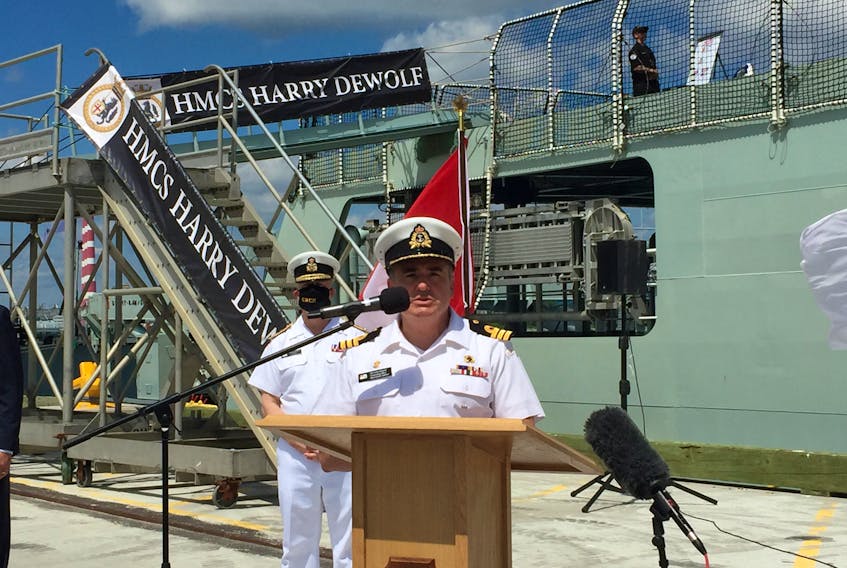The rows of sailors in their crisp white uniforms could hardly wait to file up onto their new vessel on Friday afternoon, as the Royal Canadian Navy took delivery of the future HMCS Harry DeWolf.
The first of six planned new Arctic and Offshore Patrol Vessels, or AOPVs, still had a “new-car” smell, Vice Admiral Art MacDonald told the crowd of assembled sailors and media during the ceremony held at the navy dockyards in Halifax.
The ship was built at Irving's Halifax Shipyards, under the multi-billion dollar National Shipbuilding Strategy announced in 2011.
Guests and navy brass at the ceremony included Andy Fillmore, MP for Halifax, Kevin McCoy, president of Irving Shipbuilding Inc., MacDonald, Commander of the Royal Canadian Navy, Rear Admiral Brian Santarpia, Commander of Maritime Forces Atlantic, Commodore Richard Feltham, Commander of Canadian Fleet Atlantic, and Cmdr. Corey Gleason, the ship's commanding officer.
“As a Bluenoser, I must admit there are no bad days to come to Halifax and to Nova Scotia, but that said, there are few days that are as good as this,” MacDonald said. “What an exciting day it is. You can smell it over here... It's a new car smell.”
The ship has the capability to deploy with a Cyclone helicopter and a variety of vehicles, boats and cargo containers for a “myriad” of missions, MacDonald said.
“Harry will undergo final preparations and outfitting, and provisioning here over the coming weeks before next proceeding to sea in the fall for the first time under Cmdr. Gleason's command, in order to begin progressing the navy-conducted tests and trials to develop proficiency in a variety of environments in the coming months,” MacDonald said.
“HMCS Harry DeWolf will be commissioned in summer of 2021.”
MacDonald said the ship will offer not only the capacity to work in Arctic waters, but also patrol offshore in Canadian territorial waters and beyond. It's capable of assisting in search and rescues, humanitarian missions, and more. It's envisioned it will eventually circumnavigate North America to prove it's capabilities for more than just work in the North.
McCoy said it was a historic day for the country, the navy, and his shipyard.
“The first-in-class Arctic and Offshore Patrol vessel, the lead vessel in Canada's next generation of combat ships,” he said. “At 6,600 tons, it's also the largest vessel ever built in Canada as part of a combat package. And this vessel has many firsts, including the navy's first electric-drive propulsion plant, as well as being the first purpose-built ship for Arctic operations.
“As a shipbuilder for almost 40 years, I can tell you I am immensely proud of our team and their commitment to getting it right.”
He then sat down with MacDonald to sign the official papers to deliver the vessel.
Gleason said the ship has the capacity to work in Arctic ice beyond that of other vessels. But before that, there's a lot of work still to do before it is commissioned.
“Bringing the ship into service isn't an easy thing,” Gleason said, adding that a lot of training in the operations of the ship's systems is required as well as programming to prepare to go to sea through lectures and simulations.
“And as time marches on... we'll add new capabilities like the 25-millimetre gun, we have to learn how to operate that gun, it's new to the navy,” he said. “The MRRB, our Multi-Role Rescue Boat, another beautiful boat that was built locally here, that's new to the navy, that has a long-range, over-the-horizon capability.”
During a tour of the ship, Gleason pointed out massive cranes capable of handling containers, vessels and other loads, a large flight deck to accommodate a Cyclone chopper and a maintenance hangar with a mezzanine level to allow access to higher parts of the helicopter, self-contained lifeboats that aren't usually on navy vessels support science and civilians as well as crew, state-of-the-art systems on the bridge, a station to remotely operate the 25-mm gun using joysticks, and similar stations above the flight deck that can guide a Cyclone landing and takeoff and remotely work fire-suppression foam cannons should an emergency occur with a helicopter below, and more.
The next three AOPVs are in various states of construction, with two more planned.









